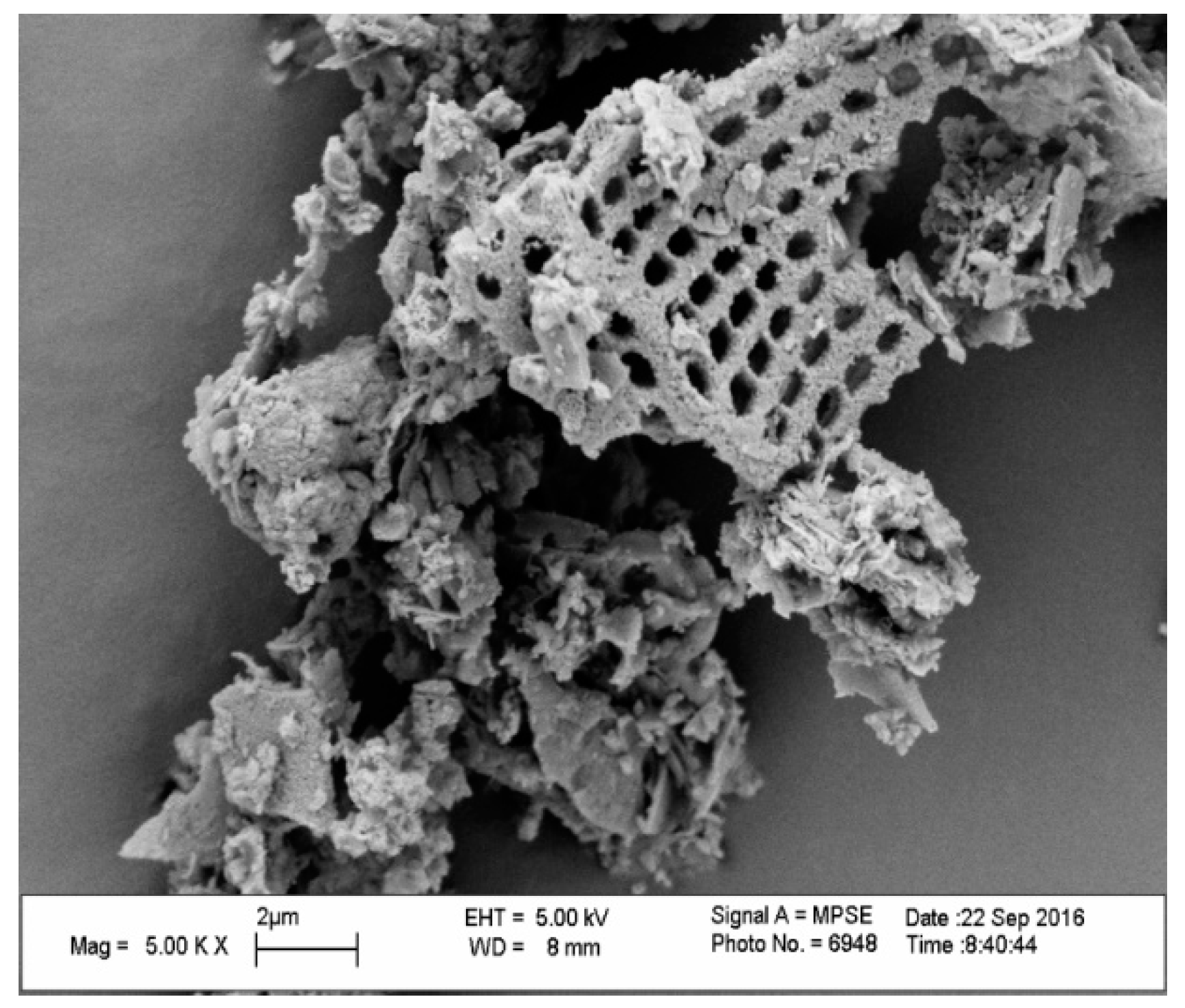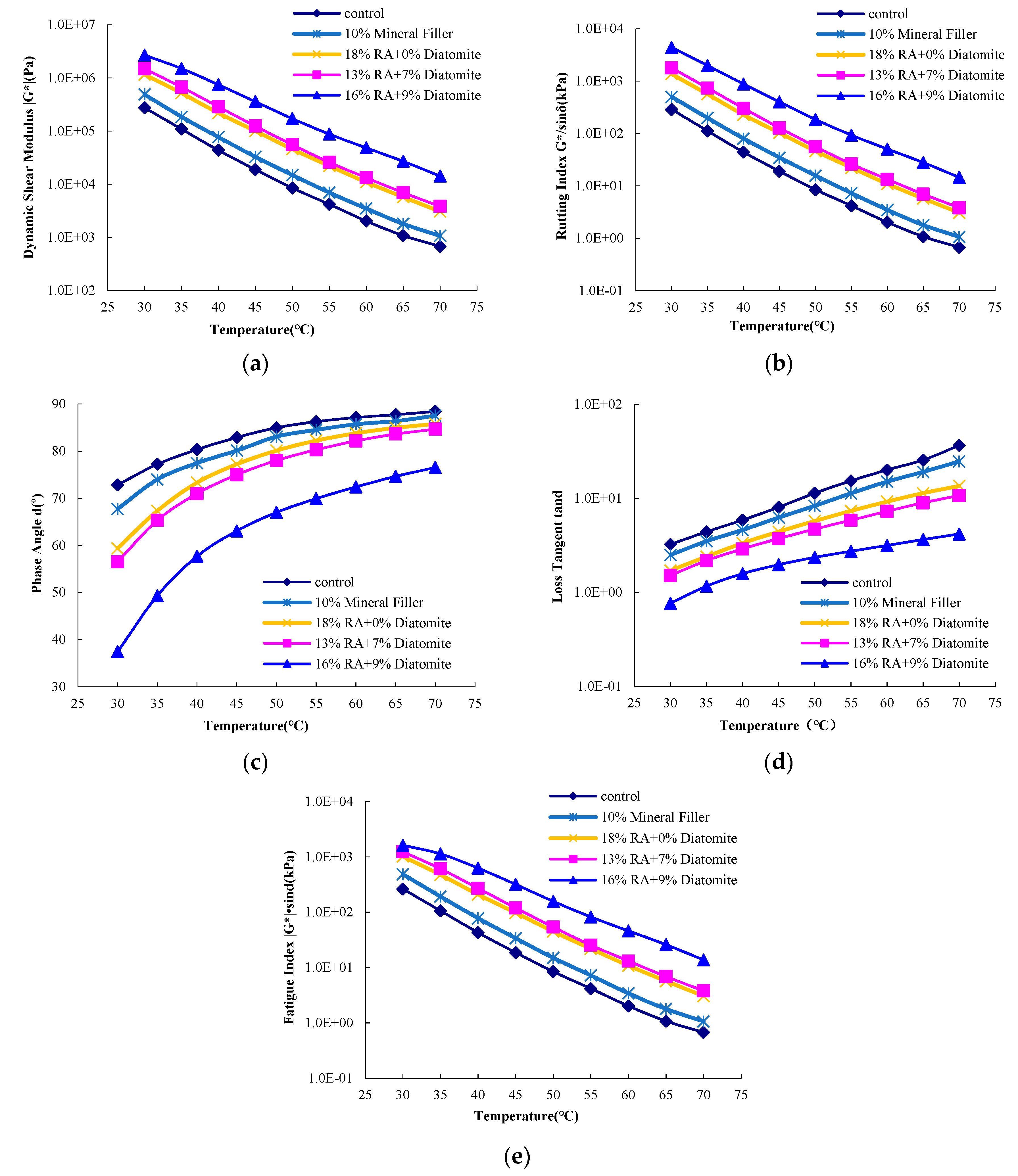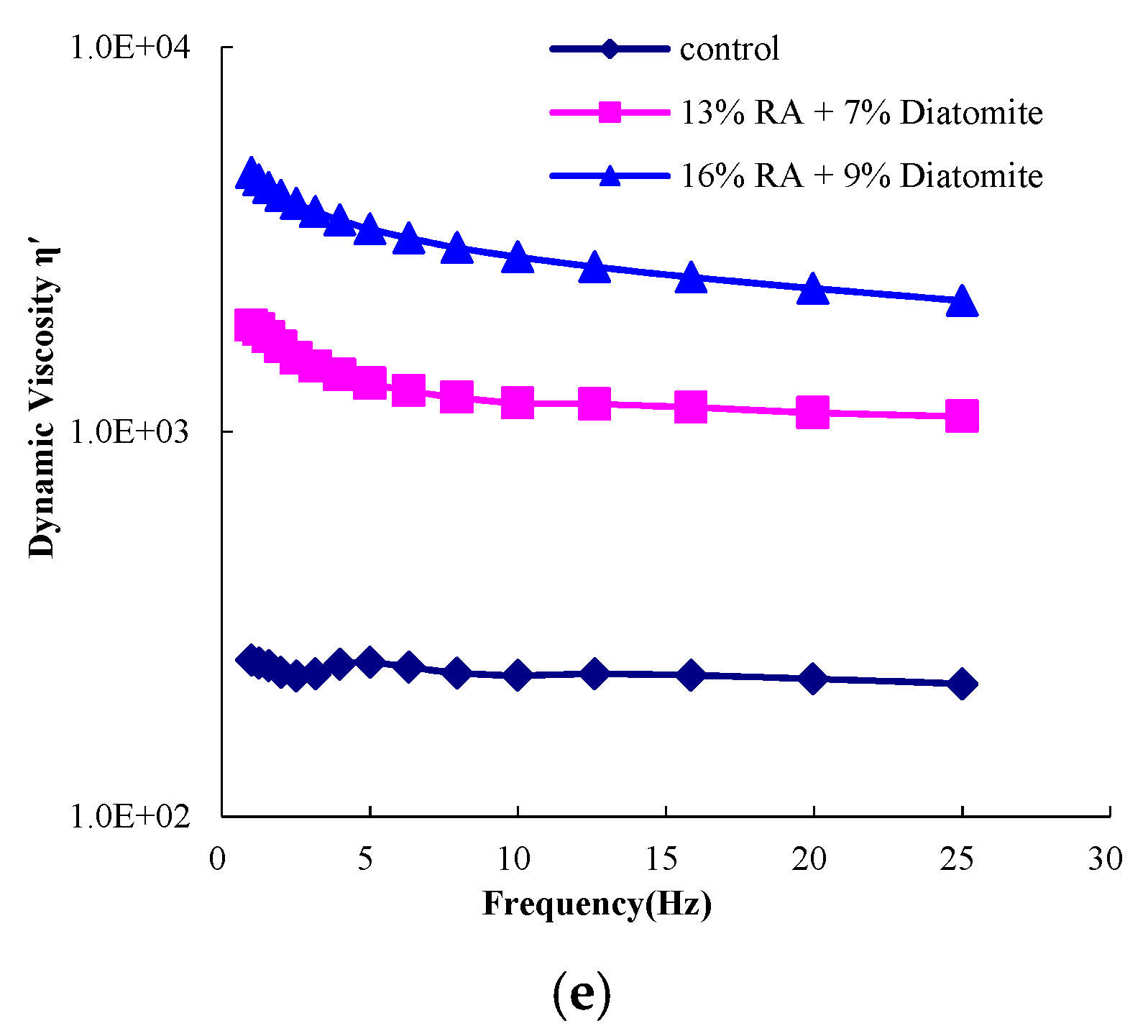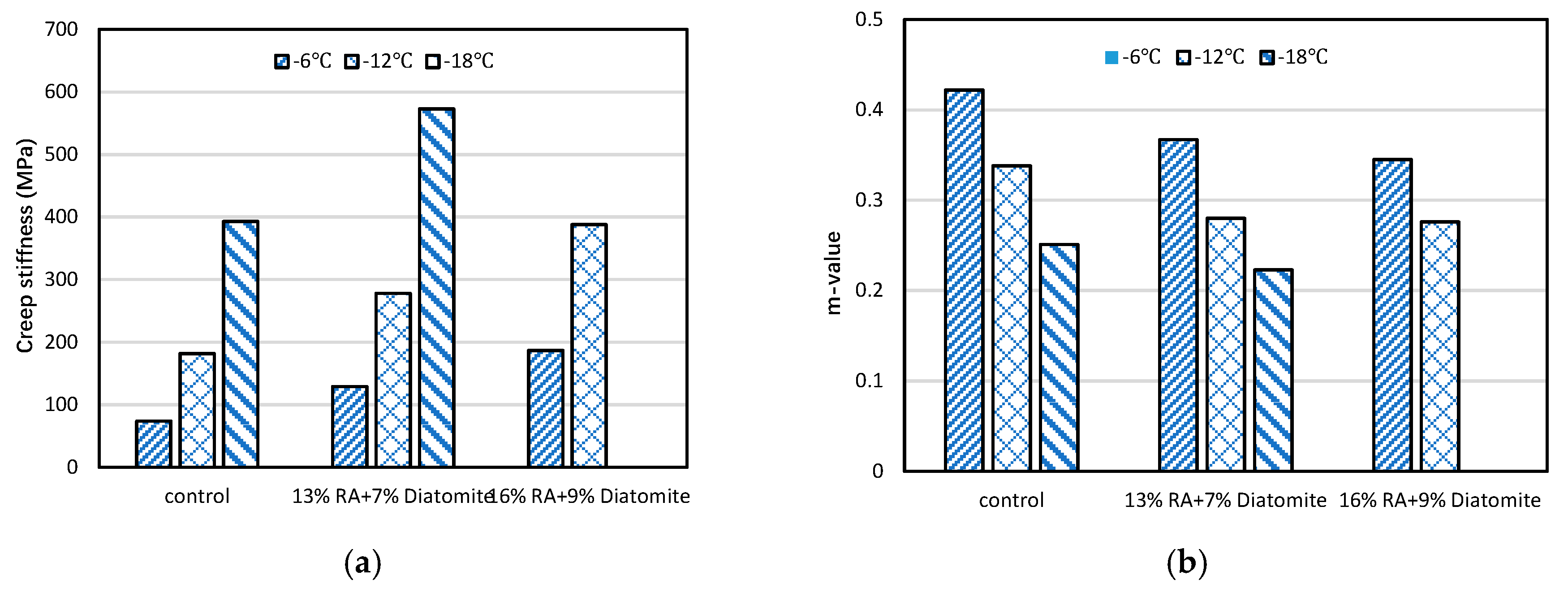Rheological Characteristics Evaluation of Bitumen Composites Containing Rock Asphalt and Diatomite
Abstract
1. Introduction
2. Materials and Preparation
2.1. Materials
2.2. Sample Preparation
3. Experimental Methods
3.1. SEM Tests
3.2. Rotation Viscosity Test
3.3. Dynamic Shear Rheometer (DSR) Test
3.3.1. Temperature Sweep Tests
3.3.2. Frequency Sweep Tests
3.4. Bending Beam Rheometer (BBR) Test
4. Results and Discussion
4.1. SEM Tests
4.2. Rotational Viscosity Test
4.3. Dynamic Shear Rheometer (DSR) Test
4.3.1. Temperature Sweep Tests
4.3.2. Frequency Sweep Tests
4.4. BBR Test
5. Conclusions
Author Contributions
Funding
Acknowledgments
Conflicts of Interest
References
- Widyatmoko, I.; Elliott, R. Characteristics of elastomeric and plastomeric binders in contact with natural asphalts. Constr. Build. Mater. 2008, 22, 239–249. [Google Scholar] [CrossRef]
- Liao, M.; Chen, J.; Airey, G.D.; Wang, S. Rheological behavior of bitumen mixed with Trinidad lake asphalt. Constr. Build. Mater. 2014, 66, 361–367. [Google Scholar] [CrossRef]
- Xin, C.; Lu, Q.; Ai, C.; Rahman, A.; Qiu, Y. Optimization of hard modified asphalt formula for gussasphalt based on uniform experimental design. Constr. Build. Mater. 2017, 136, 556–564. [Google Scholar] [CrossRef]
- Xu, G.; Wang, H.; Zhu, H. Rheological properties and anti-aging performance of asphalt binder modified with wood lignin. Constr. Build. Mater. 2017, 151, 801–808. [Google Scholar] [CrossRef]
- Kök, B.V.; Yilmaz, M.; Guler, M. Evaluation of high temperature performance of SBS + Gilsonite modified binder. Fuel 2011, 90, 3093–3099. [Google Scholar] [CrossRef]
- Huang, W.; Xu, G. Experimental investigation on the pavement performance of Buton rock asphalt mixtures. J. South China Univ. Technol. (Nat. Sci. Ed.) 2012, 40, 87–91. [Google Scholar]
- Galzerano, B.; Capasso, I.; Verdolotti, L.; Lavorgna, M.; Vollaro, P.; Caputo, D.; Iannace, S.; Liguori, B. Design of sustainable porous materials based on 3D-structured silica exoskeletons, Diatomite: Chemico-physical and functional properties. Mater. Des. 2018, 145, 196–204. [Google Scholar] [CrossRef]
- Jahanian, H.R.; Shafabakhsh, G.H.; Divandari, H. Performance evaluation of hot mix asphalt (HMA) containing bitumen modified with Gilsonite. Constr. Build. Mater. 2017, 131, 156–164. [Google Scholar] [CrossRef]
- Li, K.; Vasiliu, M.; McAlpin, C.R.; Yang, Y.; Dixon, D.A.; Voorhees, K.J.; Batzle, M.; Liberatore, M.W.; Herring, A.M. Further insights into the structure and chemistry of the Gilsonite asphaltene from a combined theoretical and experimental approach. Fuel 2015, 157, 16–20. [Google Scholar] [CrossRef]
- Sun, D. A study on xinjiang asphaltite as an asphalt modifier. Part I: Composition, structure, and thermal behavior. Pet. Sci. Technol. 2012, 30, 307–315. [Google Scholar] [CrossRef]
- Helms, J.R.; Kong, X.; Salmon, E.; Hatcher, P.G.; Schmidt-Rohr, K. Structural characterization of gilsonite bitumen by advanced nuclear magnetic resonance spectroscopy and ultrahigh resolution mass spectrometry revealing pyrrolic and aromatic rings substituted with aliphatic chains. Org. Geochem. 2012, 44, 21–36. [Google Scholar] [CrossRef]
- Zhong, K.; Yang, X.; Luo, S. Performance evaluation of petroleum bitumen binders and mixtures modified by natural rock asphalt from Xinjiang China. Constr. Build. Mater. 2017, 154, 623–631. [Google Scholar] [CrossRef]
- Huang, W.; Xu, G.; Liu, Y.; Wang, D. Study on modification mechanism of North American rock asphalt based on microstructure. Funct. Mater. 2015, 46, 12082–12086. (In Chinese) [Google Scholar]
- Zhang, C.; Li, Y.; Cheng, X.; Liang, S.; Guo, X.; Zhao, H. Effects of plasma-treated rock asphalt on the mechanical properties and microstructure of oil-well cement. Constr. Build. Mater. 2018, 186, 163–173. [Google Scholar] [CrossRef]
- Wang, M.; Lin, F.; Liu, L. Dynamic rheological properties and microscopic characteristics of ash mastics. J. Tongji Univ. (Nat. Sci. Ed.) 2016, 44, 567–571. [Google Scholar]
- AASHTO. Standard Method of Test for Determining the Rheological Properties of Asphalt Binder Using a Dynamic Shear Rheometer (DSR); American Association of State Highway and Transportation Officials: Washington, DC, USA, 2009. [Google Scholar]
- Li, Y.; Chen, J.; Yan, J.; Guo, M. Influence of Buton rock asphalt on the physical and mechanical properties of asphalt binder and asphalt mixture. Adv. Mater. Sci. Eng. 2018, 1–7. [Google Scholar] [CrossRef]
- Yin, Y.; Zhang, X. Effect of Buton rock asphalt on rheological properties of asphalt mortar at high temperature. J. Wuhan Univ. Technol. 2010, 32, 85–89. [Google Scholar]
- Li, R.; Karki, P.; Hao, P.; Bhasin, A. Rheological and low temperature properties of asphalt composites containing rock asphalts. Constr. Build. Mater. 2015, 96, 47–54. [Google Scholar] [CrossRef]
- Lv, S.; Fan, X.; Yao, H.; You, L.; You, Z.; Fan, G. Analysis of performance and mechanism of Buton rock asphalt modified asphalt. J. Appl. Polym. Sci. 2018, 1–8. [Google Scholar] [CrossRef]
- Mahyuddin, A.; Tjaronge, M.W.; Ali, N.; Ramli, M.I. Experimental analysis on stability and indirect tensile strength in asphalt emulsion mixture containing Buton granular asphalt. Int. J. Appl. Eng. Res. 2017, 12, 3162–3169. [Google Scholar]
- Wang, C.; Wang, H.; Zhao, L.; Cao, D. Experimental study on rheological characteristics and performance of high modulus asphalt binder with different modifiers. Constr. Build. Mater. 2017, 155, 26–36. [Google Scholar] [CrossRef]
- AASHTO. Standard Method of Test for Determining the Flexural Creep Stiffness of Asphalt Binder Using the Bending Beam Rheometer (BBR); American Association of State Highway and Transportation Officials: Washington, DC, USA, 2016. [Google Scholar]
- Shi, X.; Cai, L.; Xu, W.; Fan, J.; Wang, X. Effects of nano-silica and rock asphalt on rheological properties of modified bitumen. Constr. Build. Mater. 2018, 161, 705–714. [Google Scholar] [CrossRef]
- Lv, S.; Wang, S.; Guo, T.; Xia, C.; Li, J.; Hou, G. Laboratory evaluation on performance of compound-modified asphalt for rock asphalt/SBR and rock asphalt/Nano-CaCO. Appl. Sci. 2018, 8, 1009. [Google Scholar] [CrossRef]
- Cai, L.; Shi, X.; Xue, J. Laboratory evaluation of composed modified asphalt binder and mixture containing nano-silica/rock asphalt/SBS. Constr. Build. Mater. 2018, 172, 204–211. [Google Scholar] [CrossRef]
- Acurio, K.; Chico-Proano, A.; Martinez-Gomez, J.; Avila, C.F.; Avila, A.; Orozco, M. Thermal performance enhancement of organic phase change materials using spent diatomite from the palm oil bleaching process as support. Constr. Build. Mater. 2018, 192, 633–642. [Google Scholar] [CrossRef]
- Yin, H. Study on the Mechanism of Diatomite Modification and Its Application in Dry Mixing of Asphalt Mixture. Master’s Thesis, Chongqing Jiaotong University, Chongqing, China, 2012. Unpublished. [Google Scholar]
- Li, X.; Zhang, X.; Li, Z. Dynamic viscoelastic characteristics of diatomite modified asphalt mortar. Highway 2006, 10, 145–148. [Google Scholar]
- Cheng, Y.; Zhu, C.; Tan, G.; Lv, Z.; Yang, J.; Ma, J. Laboratory study on properties of diatomite and basalt fiber compound modified asphalt mastic. Adv. Mater. Sci. Eng. 2017, 2017, 4175167. [Google Scholar] [CrossRef]
- Davar, A.; Tanzadeh, J.; Fadaee, O. Experimental evaluation of the basalt fibers and diatomite powder compound on enhanced fatigue life and tensile strength of hot mix asphalt at low temperatures. Constr. Build. Mater. 2017, 153, 238–246. [Google Scholar] [CrossRef]
- Guo, Q.; Li, L.; Cheng, Y.; Jiao, Y.; Xu, C. Laboratory evaluation on performance of diatomite and glass fiber compound modified asphalt mixture. Mater. Des. 2015, 66, 51–59. [Google Scholar] [CrossRef]
- Wei, H.; He, Q.; Jiao, Y.; Chen, J.; Hu, M. Evaluation of anti-icing performance for crumb rubber and diatomite compound modified asphalt mixture. Constr. Build. Mater. 2016, 107, 109–116. [Google Scholar] [CrossRef]
- Li, J.; Zhao, X. Study on test performance of rock asphalt composite diatomite modified asphalt mixture. Road Traffic Technol. (Appl. Technol. Ed.) 2016, 4, 66–68. [Google Scholar]






| Properties | Virgin Bitumen | RTFOT Residue | ||||||
|---|---|---|---|---|---|---|---|---|
| Penetration Grade at 25 °C (0.1 mm) | Softening Point (°C) | Ductility at 10 °C (cm) | Viscosity at 60 °C (Pa∙s) | Mass Change (%) | Residual Penetration Ratio at 25 °C (%) | Residual Ductility at 10 °C (cm) | Softening Point (°C) | |
| Requirement | 60–80 | ≥46 | ≥15 | ≥180 | ±0.8 | ≥61 | ≥6 | — |
| Results | 71 | 47 | 33 | 210 | −0.2 | 72 | 9 | 53 |
| Properties | Solubility in C2HCl3 (%) | Specific Gravity at 25 °C (kg/m3) | Flash Point (°C) | Moisture (%) | ASH (%) | 1.18 mm Percentage Passing Sieves (%) |
|---|---|---|---|---|---|---|
| Results | 91 | 1153 | 298 | 0.6 | 7.0 | 100 |
| Properties | SiO2 | Al2O3 | Fe2O3 | CaO | MgO | TiO2 | K2O | Loss on Ignition (%) |
|---|---|---|---|---|---|---|---|---|
| Requirement | ≥75 | — | — | — | — | — | — | — |
| Results | 85.2 | 3.6 | 2.3 | 0.6 | 1.6 | 0.2 | 0.4 | 5.2 |
| Properties | Specific Gravity at 25 °C (g/cm3) | Hydrophilic Coefficient | Size Range (%) | ||
|---|---|---|---|---|---|
| <0.6 mm | <0.15 mm | <0.075 mm | |||
| Requirement | ≥2.50 | <1 | 100 | 90–100 | 75–100 |
| Results | 2.723 | 0.57 | 100 | 95.3 | 80.9 |
| Component | Apparent Viscosity (Pa∙S) | |
|---|---|---|
| 135 °C | 175 °C | |
| control | 0.41 | 0.08 |
| 18% RA+0% diatomite | 2.55 | 0.18 |
| 13% RA+7% diatomite | 1.84 | 0.25 |
| 16% RA+9% diatomite | 3.78 | 0.41 |
© 2019 by the authors. Licensee MDPI, Basel, Switzerland. This article is an open access article distributed under the terms and conditions of the Creative Commons Attribution (CC BY) license (http://creativecommons.org/licenses/by/4.0/).
Share and Cite
Huang, W.; Wang, D.; He, P.; Long, X.; Tong, B.; Tian, J.; Yu, P. Rheological Characteristics Evaluation of Bitumen Composites Containing Rock Asphalt and Diatomite. Appl. Sci. 2019, 9, 1023. https://doi.org/10.3390/app9051023
Huang W, Wang D, He P, Long X, Tong B, Tian J, Yu P. Rheological Characteristics Evaluation of Bitumen Composites Containing Rock Asphalt and Diatomite. Applied Sciences. 2019; 9(5):1023. https://doi.org/10.3390/app9051023
Chicago/Turabian StyleHuang, Wentong, Duanyi Wang, Peiyong He, Xiang Long, Bing Tong, Jun Tian, and Peng Yu. 2019. "Rheological Characteristics Evaluation of Bitumen Composites Containing Rock Asphalt and Diatomite" Applied Sciences 9, no. 5: 1023. https://doi.org/10.3390/app9051023
APA StyleHuang, W., Wang, D., He, P., Long, X., Tong, B., Tian, J., & Yu, P. (2019). Rheological Characteristics Evaluation of Bitumen Composites Containing Rock Asphalt and Diatomite. Applied Sciences, 9(5), 1023. https://doi.org/10.3390/app9051023






